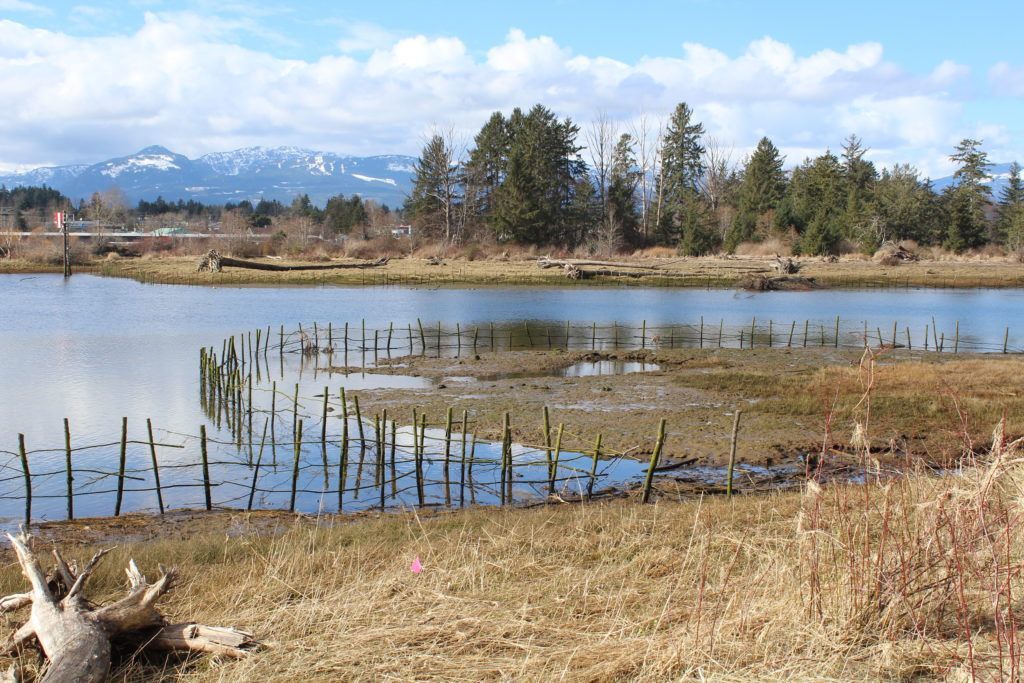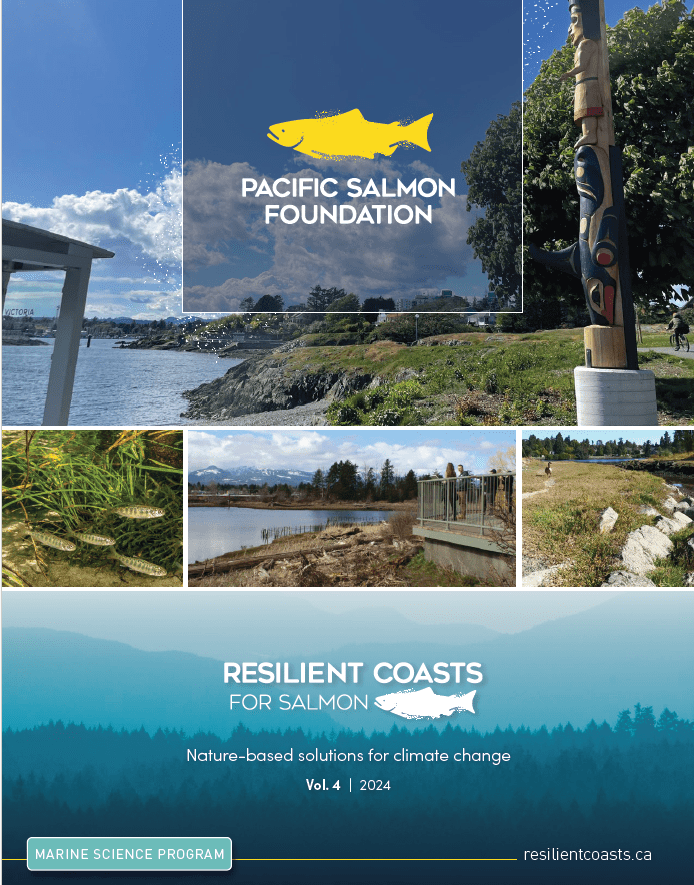Situated in an important estuary, the site will improve conditions for salmon and other wildlife whilst creating enhanced opportunities for recreational activities such as bird viewing. It will also provide opportunities for education and hands-on learning about healthy shorelines and restoration using nature-based solutions.
Resilient Coasts for Salmon is partnering with the Comox Valley Regional District, Project Watershed, Guardians of our Salish Estuaries, and the K’ómoks First Nation and their Guardian Watchmen to restore a section of the Comox Estuary shoreline at Dyke Road Park. This restoration project is a demonstration site to showcase nature-based approaches to restore marine ecosystems that support adaptability and resilience to climate change. This is a Green Shores for Shoreline Development project.

The project area is located on the Traditional Territory of the K’ómoks First Nation, situated along northeastern Vancouver Island, and spans approximately 0.6 hectares within Dyke Road Park, Courtenay. The adjacent estuary is fed by freshwater from the confluence of the Puntledge and Tsolum Rivers and is recognized as a Class 1 estuary, second in importance only to the Fraser River estuary, and one of only eight that are ranked as Class 1 in BC (World Wildlife Fund Canada, 2013). It is also a federally recognized Important Bird Area and supports 145 bird species, 218 plant species, 29 fish species (including 5 species of Pacific salmon), and an abundance of intertidal life. The Traditional Territory of the K’ómoks First Nation is referred to as the Land of Plenty because of its richness of resources including salmon, shellfish, rockfish, deer and berries. The K’ómoks First Nation and the Land of Plenty, which includes the waters of the K’ómoks estuary, have a deep relationship since the resources are foundational to spiritual beliefs, harvest practices, clothing design, and much more.
Prior to the project, the park included a covered bird watching area, an open platform, and parking area. The area proposed for restoration is outlined below in red, at the most southerly section of the 4 parcels: parcel identifier (PID) # 006-291-457.

Using a Green Shores® nature-based approach, restoration of this shoreline and components of the adjacent park area will help to reclaim the ecological and cultural values of the site, including the restoration of vital nutrient and sedimentary processes which support the extensive number of significant species found at this location, including five salmon species. The site design will likely include re-grading, stabilizing, and planting with native riparian and upland species the eroding backshore to provide habitat for amphibians, insects and birds. As well, the beach will be nourished with a sand-gravel mix of small rock pebbles, pea gravel, and sand, well suited to provide a spawning habitat for forage fish which are an important prey species for salmon and other wildlife. The beach nourishment will also help to stabilize the backshore against erosion and help to prevent coastal squeeze. Access to the shoreline will be managed to protect the riparian zone.

The project was launched with a site visit in August 2021, attended by representatives from Comox Valley Regional District, Project Watershed and the Stewardship Centre for BC. On site activities included a viewing of the different areas of the park including segments that could be considered for future phases, along with discussions about possible ideas for restoration.
Representatives from the Comox Valley Regional District, Project Watershed and the Stewardship Centre for BC met on site in August 2021 to view the Dyke Road Park location. Photo credit: Kelly Loch
A design workshop held on March 8, 2022, provided the opportunity for a larger group of partners to meet on site and then participate in collaborative design activities at the Comox Valley Regional District (CVRD) boardroom. Participants included representatives from Planning and Parks of the CVRD, the K’ómoks First Nation, Project Watershed, Guardians of our Salish Estuaries, Northwest Hydraulic Consultants, Hapa Collaborative, Paul de Greeff Landscape Architect, Stewardship Centre for BC’s Green Shores team and the Pacific Salmon Foundation. The objective of this workshop was to review site conditions and context, and discuss potential restoration strategies using Green Shores principles. Some ideas included restoration of the estuary salt marsh by removal of invasives, planting of native vegetation, tidal channel creation, and bank stabilization, and stormwater management to limit the movement of parking lot surface contaminants into the aquatic environment. These ideas will be taken forward by the design team of Hapa Collaborative while using coastal engineering studies from Northwest Hydraulics Consultants.



A project concept has now been developed by landscape architects Hapa Collaborative based on the collaborative workshop held in March 2022. The concept takes input from CVRD departments of Parks and Planning, the K’ómoks First Nation, Guardians of our Salish Estuaries, Project Watershed, Northwest Hydraulic Consultants, Paul de Greeff Landscape Architect, Stewardship Centre for BC, and Pacific Salmon Foundation.


Existing conditions (left) and project concept (right) for Dyke Road Park. Credits: Project Watershed and Hapa Collaborative.
Key features of the new design include:
Engagement with Comox Valley Regional District (CVRD) and K’ómoks First Nation
Working with the Stewardship Centre for BC on the Dyke Road Park project has provided the CVRD with an opportunity to more fully understand the Green Shores approach – from design to construction. This is invaluable experience to be able to share with our community. Demonstration projects are where local governments have the chance to “walk the talk.”
– CVRD Planner
Comox Valley Regional District recently met with K’ómoks First Nation regarding a general project overview with the latest concept plan. Key feedback from the K’ómoks First Nation included:
We anticipate a Fall 2024 construction window.

For additional updates on the progress of Dyke Road Park and the other Green Shores demonstration sites see this newsletter from June 2024.